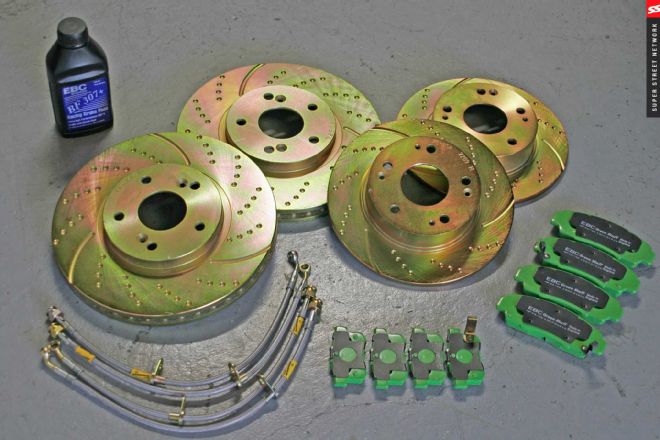Up until now, you've spent your money one of two ways: to make your whip faster than anybody ever thought it ought to be or to impress your homies at car shows with things like hard-to-get Japanese-market floor mats. Spend enough money doing the first of the two and by now you've probably figured out that being able to stop is just as important.
Whoever designed your car's brakes made sure they'd be able to bring your car to a stop no matter the circumstance, provided you aren't accelerating a whole lot faster than what they figured your 102hp single-cam engine would allow you to. Turns out they never planned on you doing that engine swap or turbo kit, which means the sort of momentum you've got to stop in its tracks now requires a whole lot more braking power.
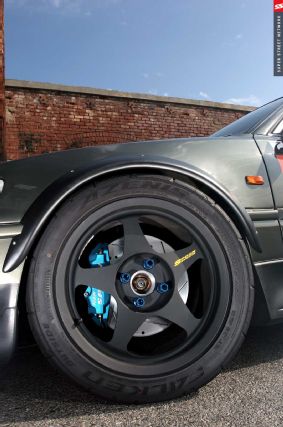 | Braking System Basics Spoon Brake Caliper
| Braking System Basics Spoon Brake Caliper
STOPPING BASICS
You not plowing over the guy in the crosswalk starts with your foot and a pedal assembly and ends with a couple of composite-, ceramic-, or metallic-based pads squeezing against a steel rotor at each corner that'll bring each tire to a halt. As it turns out, there's a whole lot more important stuff going on in between, though.
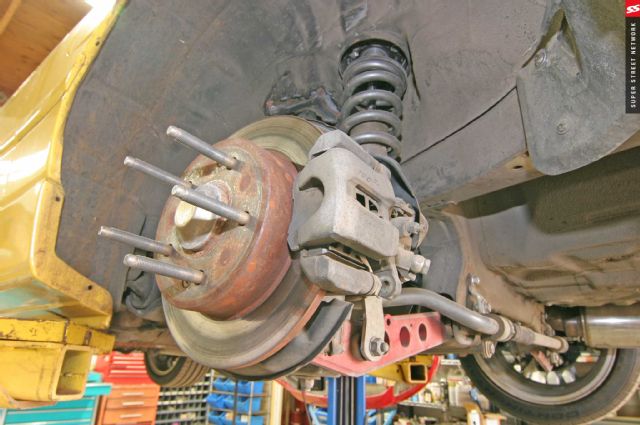 | Braking System Basics Brake Rotors
| Braking System Basics Brake Rotors
Unless you've got drum brakes, in which case you really ought to get rid of those for some rotors and calipers, your brake system is made up of rotors, which fasten to the hubs; calipers, which mount to the knuckles; and pads, which rest inside the calipers and clamp around the rotors once the pedal's depressed.
Calipers, rotors, and pads: Any brake system's most obvious bits are stashed right behind the wheels. Here's where you'll find the rotors, which fasten to the hubs and spin alongside the wheels; the calipers, which are mounted to the knuckle assembly and remain fixed; and the pads, which, when fitted inside their calipers, assume a clamping position around the rotors.
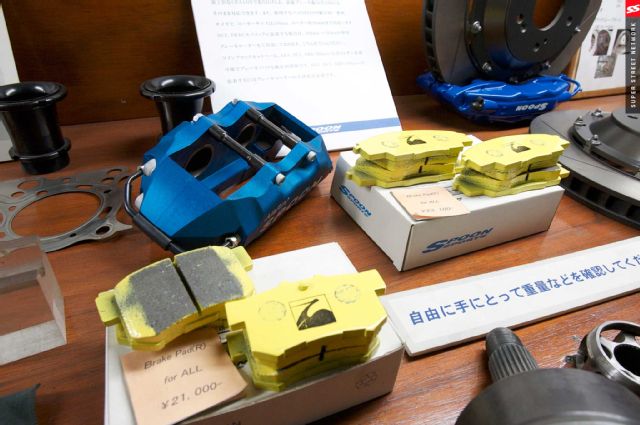 | Braking System Basics High Performance Calipers
| Braking System Basics High Performance Calipers
Every caliper has at least one piston that moves back and forth, directing the pads toward the rotor. High-performance calipers like these feature a pair of pistons for even better clamping capabilities.
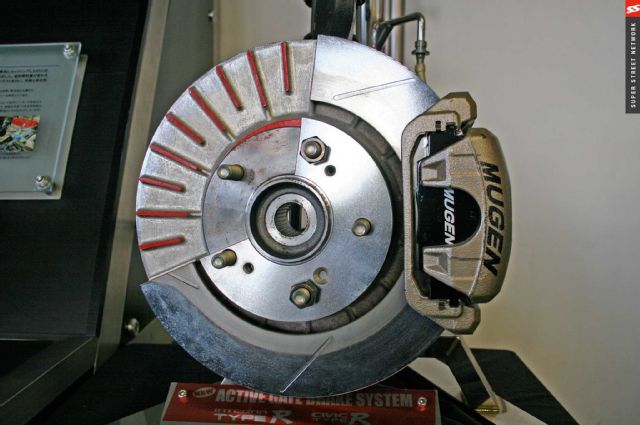 | Braking System Basics Brake Rotor Coolng Fins
| Braking System Basics Brake Rotor Coolng Fins
Every good rotor features some sort of internal venting to help dissipate heat. The vents, or fins, help direct cool air into the right places to avoid brake fade under extreme conditions.
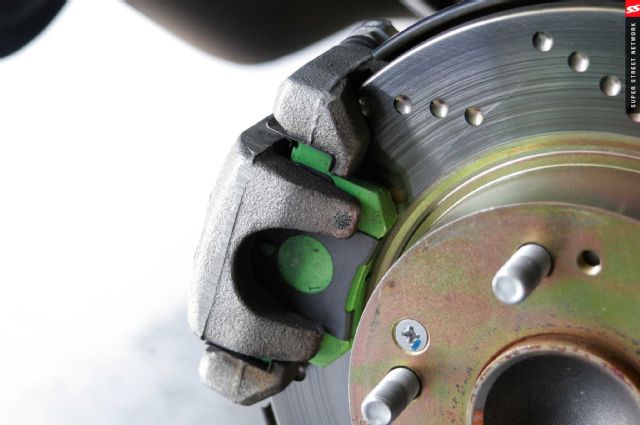 | Braking System Basics Caliper Piston
| Braking System Basics Caliper Piston
Here, the caliper's piston is located on its inner side; once it expands within its housing, both pads are compressed toward the rotor's two surfaces.
Lay off the brake pedal while moving and the rotors spin without contacting their pads. Step on it and an internal piston(s) within the calipers forces the pads against their rotors, causing everything to slow down and, ultimately, stop spinning. Since your wheels, tires, and rotors are all mounted to the same hub, your car will also conveniently stop moving when all of this goes down.
Master cylinders, pedals, and lines: In between the brake pedal and the calipers lies a hydraulic system that translates your stomp of the foot to those pads squeezing down on those rotors. Step on the brake pedal and a linkage engages a piston that's located inside the brake master cylinder mounted someplace on the firewall. Here, hydraulic fluid gets pumped through a series of lines that allows each caliper's piston(s) to move in or out, forcing the pads against the rotors and creating the sort of friction that'll slow everything down. Let off the pedal and, all of a sudden, the master cylinder's piston retracts, freeing up space for all of that hydraulic fluid and allowing each caliper's piston(s) to retract.
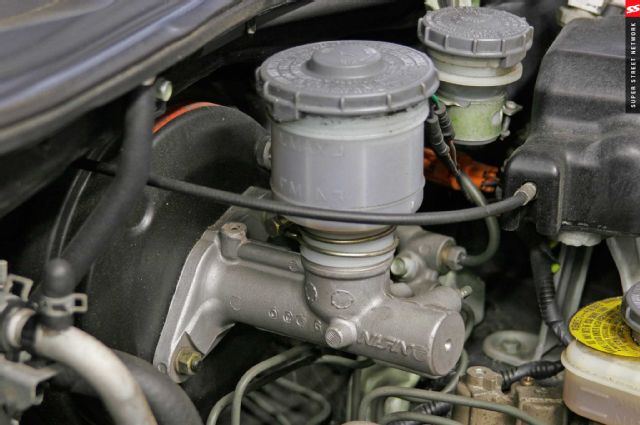 | Braking System Basics Brake Master Cylinder
| Braking System Basics Brake Master Cylinder
The brake master cylinder directs hydraulic fluid to the calipers once your foot's slammed the pedal down, expanding each caliper's piston(s), forcing their pads against their rotors. Old fluid or not enough of it can result in mushy-feeling brakes and all of this not going as planned.
KNOWING WHEN TO UPGRADE
You not being able to avoid pouncing into the Cadillac in front of you isn't your only means of knowing whether or not your brakes aren't up to snuff. Aside from normal indicators like squeaks or the sort of metal-on-metal gnashing sounds that mean something expensive just happened, consider the effects of brake fade or a mushy-feeling pedal.
Brake fade happens when an otherwise perfectly functioning set of pads decides it isn't capable of bringing your sled to a stop anymore. It can happen for a variety of reasons, too, but all of them come down to one thing: too much heat. Track day antics or you just driving like a loon on the street can all lead to excessive heat and your stock brakes no longer being able to do what you tell them to.
You never changing your brake fluid as well as old, swelled-up brake lines can also lead to poor braking and can be determined by how soft your brake pedal feels. Be sure to give your tires a once-over, too, before making any sort of braking upgrades. Your tires are your last line of defense when trying to avoid that guy in the crosswalk; even the best brakes around won't make up for crappy rubber.
HIGH-PERFORMANCE RECIPE
You almost walloping into that Cadillac was your first indication that some sort of brake upgrade has to happen. Your first inclination is a big-brake kit that's worth more than your Civic but, as it turns out, there are all kinds of more affordable upgrades that'll likely give your street car all the stopping power it needs.
Pads: A high-performance brake system is only as good as its pads. The right pads can put up with a whole lot more heat, which means you're one step closer to warding off brake fade. Get the wrong ones, though, and you can introduce all sorts of problems you'd never considered, like noise or premature rotor wear due to compounds that aren't suited for the type of driving you do.
Before hitting the order button, you'll also want to consider a pad's temperature range and friction coefficient. Its temperature range will simply tell you how hot it can get and still work the way it ought to. If you live in a colder climate, you'll want to pay closer attention to these numbers; you think hotter's better until your brakes barely work on that 10-degree morning.
A pad's friction coefficient tells you how well it'll do its job holding onto its rotor. The higher the number, the better it'll grab. Here, look for two numbers, the first of which reveals the pad's initial bite and the second its maximum. The closer the numbers are to one another, the more consistent or predictable the pads.
Brake pads can be made from a variety of materials, which, most of the time, will determine their use. For example, non-metallic, composite pads are typically gentle on rotors but won't last nearly as long as other materials. Metallic pads, on the other hand, can last much longer but are noisy and can wreak havoc on a set of rotors, which makes them more suitable for racing. Ceramic pads are one of the best compromises, offering superior resistance to brake fade, like metallic pads, and a decent friction coefficient, like non-metallic pads. That said, ceramic pads don't always deal with heat as well as other materials. In terms of your street car, EBC Brakes' Greenstuff pads, for one, are a good compromise. Here, rotor wear, dust, and noise are minimal, while stopping power is increased by as much as 15 percent. You being honest with yourself is the only way you'll ever end up with the right pads, though. For example, if your car spends most of its time on the street, consider pads that'll provide linear stopping power despite heat changes yet still limit dust and noise.
Rotors: The rotors your car was originally sold with are nothing more than fairly uninteresting looking steel discs that feature a series of vanes positioned in between their two halves to help ward off heat. Slotted and cross-drilled rotors feature, you guessed it, a series of slots or holes cut part way into their faces that help prevent pad glazing. Contrary to what you think you know, the slots and holes aren't just there to cool things down but to continually refresh the pads each time they go around. Yeah, each machined groove or hole draws cool air into its space but also helps cut through brake dust as well as rain or snow for better performance.
Look to StopTech or DBA for both affordable cross-drilled and slotted applications that work with the factory calipers. Both also offer revised cooling vanes that help limit brake temperatures, which can reduce fade and increase performance.
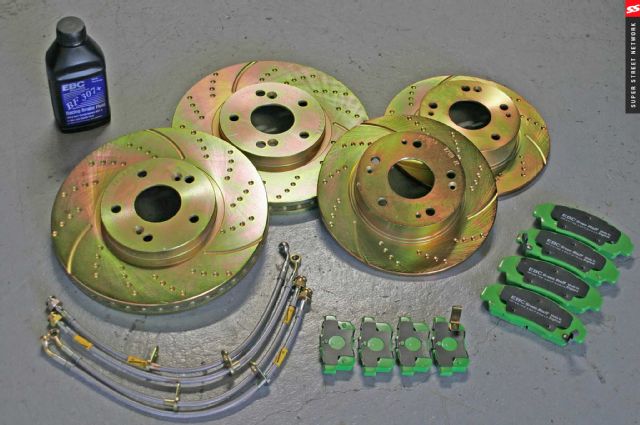 | Braking System Basics Slotted Brake Rotor
| Braking System Basics Slotted Brake Rotor
Slotted rotors don't just allow for additional cooling; their carefully cut and positioned slots help keep pad surfaces free of dust and debris by continually scraping them when turning.
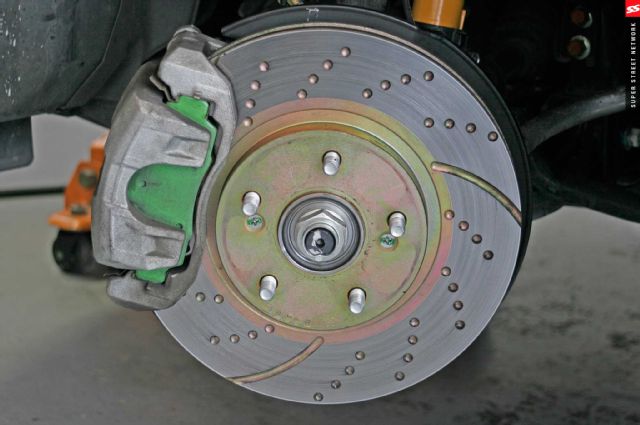 | Braking System Basics Cross Drilled And Slotted Rotor
| Braking System Basics Cross Drilled And Slotted Rotor
Here, a combination of cross-drilled and slotted technology has been used. In order to preserve the integrity and strength of the rotor, the holes aren't typically drilled all the way through.
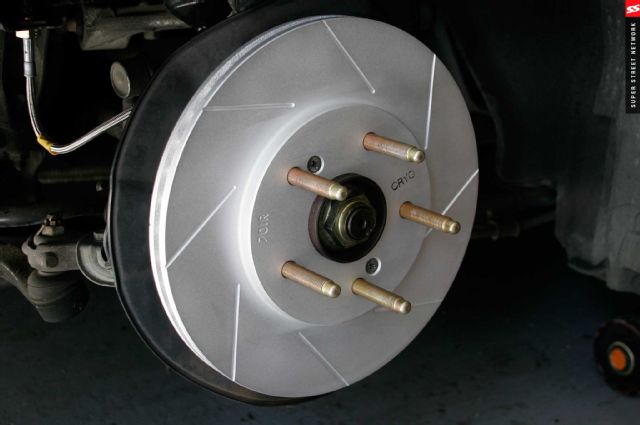 | Braking System Basics Cryo Treated Rotor
| Braking System Basics Cryo Treated Rotor
Various treatment options are available for most aftermarket rotors, like cryo-treating, which improves stress relief and heat-cycling characteristics.
Lines: The web of lines that spans between your car's brake master cylinder, its calipers, and, in some cases, an ABS system, are, for the most part, made of rigid steel tubing. To allow for chassis flex and suspension articulation, though, short sections of high-pressure rubber hose finish off the connection at each caliper. Without some flexibility here, the rigid lines would fracture, creating all sorts of problems. As is often the case with rubber, those flexible factory brake lines can swell or deteriorate over time and, even when new, can flex a whole lot when pedal pressure's applied, resulting in mushy-feeling brakes. Steel-braided lines like those from Goodridge, for one, that feature a harder, inner Teflon lining are the answer to both problems and they'll likely outlast everything else on your car.
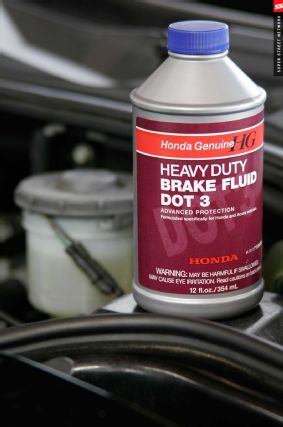 | Braking System Basics Brake Fluid
| Braking System Basics Brake Fluid
Teflon-lined, steel-braided brake lines that replace the factory rubber hoses result in a firmer pedal feel and more positive braking.
Fluid: Good brake fluid won't make an otherwise hopeless set of brakes better, but it can mean the difference between you taking full advantage of a thoroughly upgraded system or not. Like pads, different kinds of brake fluid respond better to higher temperatures and are broken down by their boiling points. Brake fluid can be split up into four types: DOT 3, DOT 4, DOT 5, and DOT 5.1. The higher the number, the higher the boiling point, however, unlike the other three, DOT 5 is silicone-based, not glycol-based, which means you'll want to stay away from it unless you plan on flushing your system a whole lot more frequently than you already do.
For most street applications, OEM brake fluid works fine. Be sure to flush your system every couple of years to avoid a mushy-feeling pedal and contaminants within the lines.
Which, by the way, should be about every two years. That may sound excessive, but consider the small amount of water your brake fluid absorbs over time. In case you didn't know, water boils quicker than brake fluid, which means your brake pedal's all of a sudden gone soft for something that could've easily been prevented.
Unless you spend a whole lot of time at the track, a capable brake system doesn't have to be overly complex or expensive, and, in some cases, may just mean a decent set of pads, some fresh rotors, and making sure your tires aren't fit for the recycling bin.
 | Braking System Basics Ebc Brake Kit
| Braking System Basics Ebc Brake Kit
A capable brake system for your street car doesn't have to be overly complex or expensive. With the right pads, rotors, lines, and fluid, like all of this from EBC Brakes, it's easy to put something together that's exponentially better than what the factory had in mind.
PROS AND CONS
Pros
- More stopping power is never a bad thing
- Better braking means better track times
- Increased safety is always good, too
- Makes for a well-rounded build
Cons
- Not as glamorous as new wheels or aero
- Not as exhilarating as engine mods
- Wrong components can wear faster than factory brakes
- Wrong components can make more noise than factory brakes
 | Braking System Basics Brake Rotor
| Braking System Basics Brake Rotor

